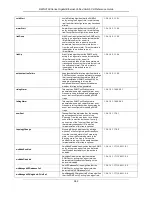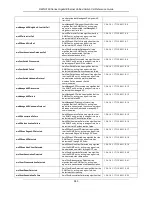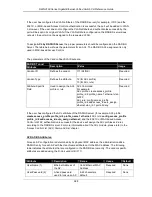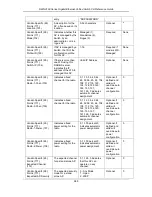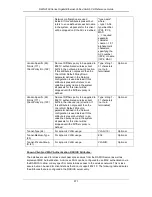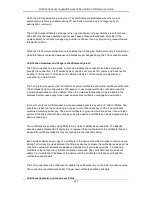
DWS-3160 Series Gigabit Ethernet Unified Switch CLI Reference Guide
976
The decision to transition out of the Cluster Controller state is immediate. If the Switch elects itself
as the Cluster Controller immediately. If the Switch elects another Switch as the Cluster Controller,
then the decision to declare that Switch as the Cluster Controller is delayed for the duration of the
keep-alive timer interval. If another Cluster Controller is detected during this interval, then the
delay timer is restarted. The administrator looking at the Switch status during the delay period
would see that the Switch is not the Cluster Controller and the Cluster Controller address is 0.0.0.0.
In this release the keep-alive timer interval is fixed at 120 seconds.
Each peer Switch independently establishes connections with other peer Switches. In a transient
case, it is possible that one of the Switches, that just established a connection with another Switch,
does not see all the Switches that the other Switch is seeing, so that the two Switches may select
different Cluster Controllers. Although the WIDS security functions do not work correctly when peer
Switches disagree about which Switch is the Cluster Controller, this condition does not affect data
forwarding through the network and normal operation is restored as soon as all the Switches in the
peer group discover each other.
Since the Cluster Controller function may be disabled by setting the Cluster Priority to zero, it is
possible that all wireless Switches in the network are configured to disable the Cluster Controller
function and the network operates without the Cluster Controller.
The Cluster priority is a global Switch configuration setting. When the global configuration is
pushed from one peer Switch to another, the Cluster priority is not included in this configuration
because its purpose is to differentiate the preference level for the Cluster Controller function for
each Switch.
There are two Switch status parameters that reflect the results of the Cluster Controller election
process. The status parameters are the
IP address
of the elected Cluster Controller and a
Boolean flag
which indicates whether this Switch is the Cluster Controller. The flag does not
provide extra information since it is derived from comparing the Switch’s IP address with the
Cluster address, but it offers a quick way for the administrator to know whether the local Switch is
the Cluster Controller.
After the Switch decides that it is the Cluster Controller, it sends an SNMP trap.
X.509 Certification Mutual Authentication:
X.509 Certification Mutual Authentication
When the wireless system is configured to perform X.509 Mutual Certificate exchange the
Switches and APs configure the TLS connection to perform mutual X.509 certificate exchange.
Each device compares the certificate received from the remote end-point with the local copy of the
remote device's certificate. If the certificates do not match, then the TLS connection is dropped.
The X.509 certificates are auto-generated by the Switches and the APs, so the devices don't
communicate with any trusted certificate authority and the administrator is not required to pay
certificate maintenance fees. Each Switch holds a copy of the X.509 certificate for all other
Switches and the APs it manages. Each AP holds a copy of the X.509 certificate of the Switches to
Содержание DWS-3160-24TC
Страница 1: ......
Страница 13: ...DWS 3160 Series Gigabit Ethernet Unified Switch CLI Reference Guide 9 R refresh the displayed pages ...
Страница 271: ...DWS 3160 Series Gigabit Ethernet Unified Switch CLI Reference Guide 267 ...
Страница 586: ...DWS 3160 Series Gigabit Ethernet Unified Switch CLI Reference Guide 582 ...
Страница 766: ...DWS 3160 Series Gigabit Ethernet Unified Switch CLI Reference Guide 762 ...

